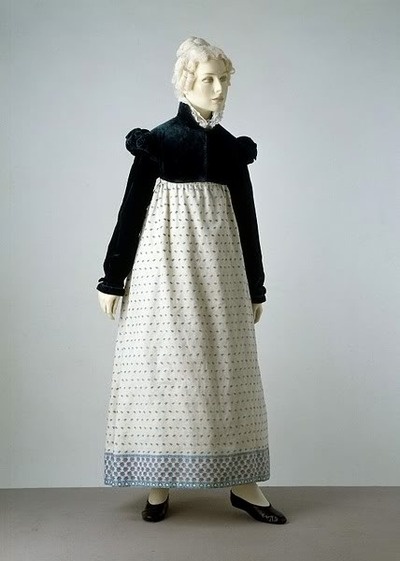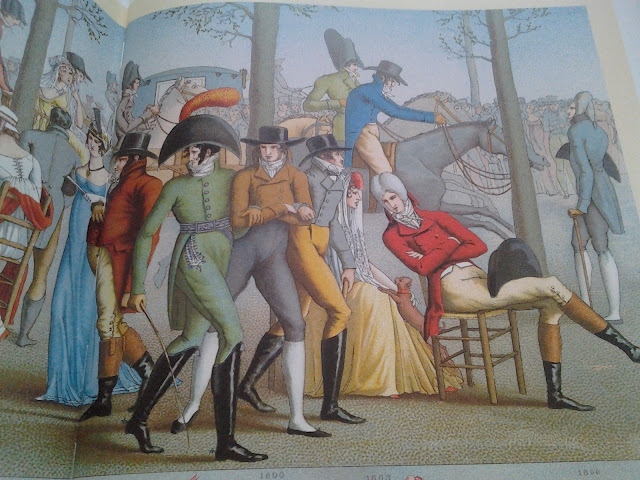The French Revolution that began in 1789 changed everything. Well, everything in Europe, and fashion. The American Revolution in 1776 didn't affect fashion all that much. Maybe because no one in Europe cared about what sort of rags the colonies managed to dress themselves in. Maybe because the Americas were busy building a nation and weren't so interested in changing fashion. Probably because the folks in the states didn't overthrow a monarchy. I mean, sure, we rejected unfair taxation and non-representational government, but there wasn't actually a king on U.S. soil. The Declaration of Independence was just an expansion of the sense of social equality and the right to profit from one's own labor that was the backbone of Yankee culture.
The French, though, they overthrew the established monarchy of a major world power. This was something totally different and exciting and inspiring. Beethoven wrote a symphony about it. (Here's a video if you want to listen to it while you read the rest of this post.)
The other cool thing about this time is that it all happened only about 225 years ago! This is awesome because there are actual items of clothing from the period that we can look at! With the Enlightenment the gentlemen scientist became a thing. Dudes like Isaac Newton thought about physics and Franklin played with electricity, and everyone began thinking that maybe Copernicus was on to something with his non-heliocentric idea about the universe. Folks started taking scientific voyages and the whole era was called the Scientific Revolution. Well, the emergence of natural history as a thing meant that fashion also began to be collected and studied which leads me to the the largest book I own:
This seven pound book is filled with illustrations of clothing, silverware, hats, weapons, and anything else Auguste Racinet, the author, felt like drawing pictures of. Here are some photos of the illustrations:
Now, let's contrast these images with some photographs of the clothing actually worn in this period:
 |
| Yup. It's that sheer in the bust. |
 |
| And, yes, I am aware that these are all white dresses and there is no menswear or color but they are just so PRETTY! |
So, that's all very Australian, but what does that mean for us? Well, it is one of the reasons we try to go back to original sources when we study something. You could read Darwin's theory of evolution, or you could read interpretations of what Darwin's theories are. You could read the scriptures, or you could read interpretations of what people think the scriptures mean. Anytime you move away from original sources, you leave a lot of room for historical or cultural bias, and this can really affect how you think about the idea, or if you even think about it at all. So, now that we have clothing which has been preserved for us to actually see (original source) we can make our own determinations about it's function and filter the data through our own cultural bias. (Because that's what this entire class really is - Susan's Fashion bias!) For a long time we have been working from paintings and while this gives us some information, it's also like learning about what we wear by looking at fashion illustrations.
 |
| Our ancestors will be shocked to discover that none of us actually looked like this. |
 |
| Modern hair, leather pants, a shocking lack of bulky furs, and a totally codpiece-free zone. |
So, now that I have gotten my random commentary over with, let's begin to actually look at the styles that evolved. If you will recall the painting at the beginning of this post
 |
| this one |
 |
| i.e. pretty naked. |
 |
| Yes, they would wear a slip under the lower half of this. Don't panic. |
Bonus points for the women who could afford to dress in sheer fine muslin because it was even more Greek goddess-like. This style might also have become popular because it mimicked the chemise that aristocratic women were stripped down to when in prison waiting for their heads to be chopped off. But, most probably, it represented the discarding of all the trappings and side baskets and florid details of the old style and demonstrated how enlightened people dressed and thought and moved.
 |
| New style mocking Old Style |
The Wikipedia page about this era in fashion waxes eloquent over the social ramifications of this change:
Fashion in the period 1795–1820 in European and European-influenced countries saw the final triumph of undress or informal styles over thebrocades, lace, periwig, and powder of the earlier 18th century. In the aftermath of the French Revolution, no one wanted to appear to be a member of the French aristocracy, and people began using clothing more as a form of individual expression of the true-self than as a pure indication of social status.[1] As a result, the shifts that occurred in fashion at the turn of the 19th century granted people the opportunity to present new public exterior identities that provided insights into their individual private selves. Katherine Aaslestad indicates how "...fashion, embodying new social values, emerged as a key site of confrontation between tradition and change."[2] For women's dress, the day to day outfit of the skirt and jacket style were practical and tactful, recalling the working class woman.[3] Women's fashions followed classical ideals, and tightly laced corsets were temporarily abandoned in favor of a high-waisted, natural figure.[4] This natural figure was emphasized by being able to see the body beneath the clothing. Visible breasts were part of this classical look, and some characterized the breasts in fashion as solely aesthetic and sexual.[5] In Britain, Beau Brummell introduced trousers, perfect tailoring, and unadorned, immaculate linen as the ideals of men's fashion. In Germany, republican city-states relinquished their traditional, modest, and practical garments and started to embrace the French and English fashion trends of short-sleeved chemise dresses and Spencer jackets.[6] American fashion trends emulated French dress, but in a toned down manner with shawls and tunics to cope with the sheerness of the chemise.[7] However, in Spain, members of the Aristocracy, as well as citizens of the lower class, united and rebelled against French enlightenment ideals and fashion by dressing as majas and majos to contain their Spanish pride.[8]
So what did this look like?
 |
| Mom and servant girl are both draped in pashminas/shawls. All of them are trying to not get their feet muddy by walking on the Paris streets |
Well, women wore a lot of white. Younger women in particular were encouraged to wear white or very light pastels. Older women would wear darker colors but generally only as accessories or jackets. The long-sleeved, high collar jackets worn over chemise after the initial explosion of the style in the early 1800's were called Spencer jackets, or just Spencers, and they were definately part of the daytime/outside look of every woman.
 |
| I have no idea why this mannequin was posed in a "I will cut you" style |
High heel shoes became impossibly out-dated and made you look like an aristocrat, i.e. someone who wanted her head cut off. Flats were the more natural, Grecian, not murder-inducing choice.
Also hugely popular at the time are shawls, or pashminas. A finely woven woolen shawl with paisley or floral designs from India or the Near East could cost some serious money and were the pride and joy of the women who owned them. They were used every day, all day, because they were basically wearing nightgowns and it was COLD, and it was not uncommon for a woman to pass down her shawl to her daughters.
 |
| Though I suppose she MIGHT give it to her son if he behaves.. |
Seriously, I love those things.
Anyway, right at the beginning of this style women in France may also have worn a baby-bump pillow on their stomachs to make them look sort of pregnant, or like they were NOT starving like everyone else in France was. You may remember this wanting-to-look-pregnant idea before, from the time right after the Black Death, as something that happens after a horrific number of people die. It sort of makes sense when you think about how the French killed 40,000 people via guillotine. But, that was in France, poor dears, everyone else just wanted to look natural and lovely, connected to the working classes, intellectually connected to science and rights of man, and maybe to show off their chests a bit.
 |
| "Sounds good to me!" |
What were men wearing? Well! Trousers to start with. Breeches as a style start to fade, as does frivolous ornamentation, silks, giant waistcoats, coats that don't button, powdered hair, and not taking baths. The tricorn and bicorn hats became less popular and the conical hat, which soon evolved into the top hat, was THE hat for the next century.
Men's coat also became either long great coats, or cut away tail coats, all with tall collars, and the waistcoats were usually double-breasted and had tall collars as well.
 |
| Cut-away tailcoat with long trousers |
 |
| Grey greatcoat with brown velvet collar. |
And I'm bored. Here's your test:
https://docs.google.com/forms/d/1dup2qZ0awfmUWV1HjLoV_JxQUHs-mVTn2VZiv2530Z4/viewform
.jpg)
























































